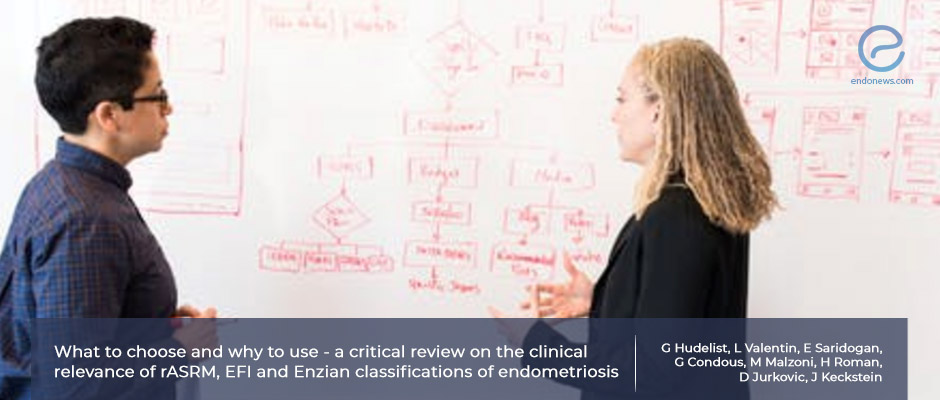A comparison of endometriosis Classifications: rASRM, EFI or Enzian?
Mar 17, 2022
The current classification of endometriosis is insufficient to cover probable surgical complexity and symptoms including infertility.
Key Points
Importance:
- An ideal classification system of endometriosis should be related to surgical complexity and the symptoms including infertility besides describing the sites and extension of the disease.
Highlights:
- Revised Enzian classification for endometriosis offers a useful description of sites, the extension of the disease, and is also related to surgical complexity as well as associated symptoms.
What's done here:
- The authors from Austria, Germany, and Sweden reviewed selected literature to evaluate and compare the 3 major classifications of endometriosis (rASRM, EFI, and Enzian).
- They highlighted the clinical success of the recently updated Enzian classification when applied to a variety of endometriosis cases.
Key Remarks:
- Neither the rASRM nor the EFI classification of endometriosis reflects the whole spectrum of the disease. The main problem is to describe retroperitoneal and deep infiltrating disease phenotypes.
- Developments in imaging improved the noninvasive diagnosis of endometriosis and helped to be aware of the extension of the disease before surgery.
- The great advantage of Enzian classification is its availability to describe the disease on ultrasound and /or MRI.
- There is increasing evidence of sufficiency for predicting surgical complexity and complications when working with the Enzian system.
- More research needs to evaluate the association between Enzian classification and the symptoms of endometriosis, surgical complexity, and its predictability for infertility.
Lay Summary
None of the endometriosis classifications provide a clinically valuable system since the very first description of the disease in 1860. One unique terminology to describe the localization and the extension of the disease is needed, which should be the same for surgeons and imaging experts. A common language is essential due to the multidisciplinary aspect of the disease that involves radiologists, sonographers, gynecologists, and experts in gynecological, colorectal, and urological surgery.
One of the major classifications for endometriosis is rASRM (revised American Society for Reproductive Medicine classification) that presented in 1996. This four staged system allows the assignment of changes related to ovaries, peritoneum, and fallopian tubes depending on whether the lesions are deep or superficial, in addition to the size and type of the endometriotic lesion. This classification can only be made by visualizing the lesions that are strongly based on laparoscopic findings. Although rASRM was mainly referred classification of endometriosis for almost 40 years, it cannot describe the adenomyosis, deep endometriosis in extragenital organs, or in pelvic organs such as bowels, bladder, rectovaginal septum, ureters.
Endometriosis Fertility Index (EFI) classification appeared in clinics in 2010. Unfortunately, this system is primarily for the prediction of pregnancy rates of patients following endometriosis surgery and gained success among clinicians who worked with assisted reproductive techniques.
The third major classification that focuses attention is the Enzian classification created by the Austrian-German-Swiss Scientific Endometriosis Foundation and published in 2003. Their main concern was to describe and add the deep infiltrating endometriosis that was missing in the rASRM classification. The pelvis was divided into three compartments to distinguish the depth and the grade of the deep endometriotic lesions on different pelvic organs as well as the diaphragm, abdominal wall, and nerve-sacral root.
Hudelist et al, from Vienna, Austria, reviewed the current literature to compare the highlights and advantages of three endometriosis classification systems. This interesting paper was recently published in the Journal of Facts Views and Vision in Obstetrics Gynecology is aimed to draw attention to the recently revised Enzian classification and is an invitation to further research to validate this system regarding the relation between symptoms and surgical complexity.
Research Source: https://pubmed.ncbi.nlm.nih.gov/35026095/
deep endometriosis classification systems rASRM EFI Enzian classification infertility surgical complexity endometriosis.

